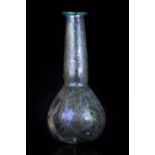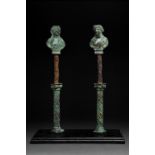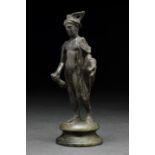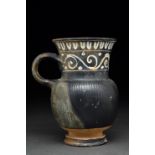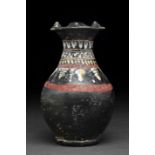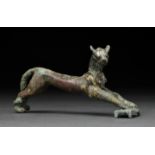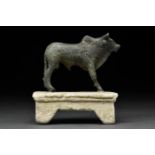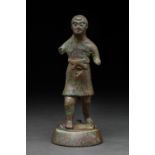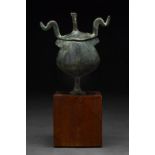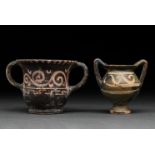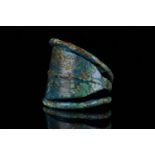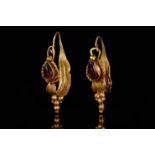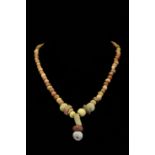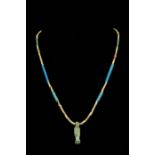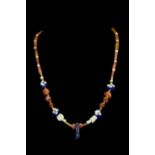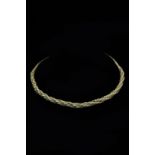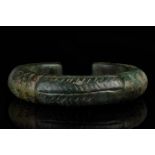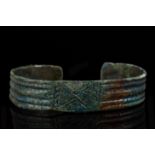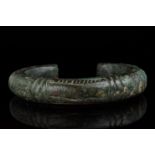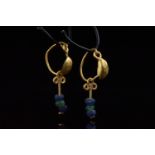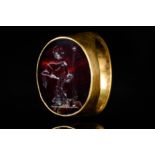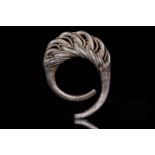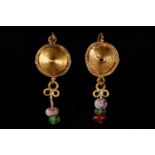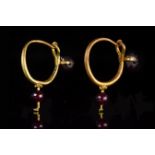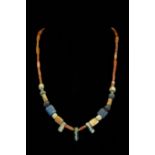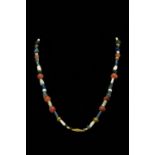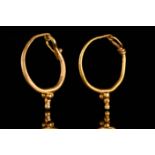Verfeinern Sie Ihre Suche
Schätzpreis
Kategorie
- Arms, Armour & Militaria (108)
- Greek, Roman, Egyptian & Other Antiquities (68)
- Jewellery (41)
- Sculpture (35)
- Chinese Works of Art (32)
- Glassware (11)
- Ceramics (5)
- Coins (5)
- Collectables (4)
- Porcelain (4)
- Islamic Works of Art (3)
- Stamps (3)
- Books & Periodicals (2)
- Metalware (2)
- Scientific Instruments (2)
- Taxidermy & Natural History (2)
- Kitchenalia (1)
- Textiles (1)
- Vintage Fashion (1)
- Liste
- Galerie
Ein Abonnement der Preisliste ist notwendig um Ergebnisse, von Auktionen die vor einem längeren Zeitraum als 10 Tagen stattgefunden haben, ansehen zu können. Klicken Sie hier für mehr Informationen
Ca. 664- 332 B.C. Late Dynastic Period, Saite Period. Egyptian. An ancient Egyptian bronze figure of Osiris standing mummiform with his hands emer...
COLLECTION OF ROMANA GLASS FLASKS
ca. 100 - 300 AD. Collection of 6 Roman glass balsamarium flasks with two tubes; fine condition. Provenance: From a London private family collecti...
ROMAN GLASS BOWL
Ca. 200–300 AD. A small Roman mould-blown glass bowl with blue hues and beautiful iridescence. The base, which shows a pontil scar, leads outwards...
ROMAN GLASS UNGUENTARIUM
Ca. 100–200 AD. Roman. An unguentarium with a piriform body, long tapering neck, and rolled rim. The base is flat and gently thickened at the cent...
ROMAN GLASS UNGUENTARIUM
Ca. 100–300 AD. Roman. A beautiful pale dark blue glass candlestick unguentarium with an out-turned rim, cylindrical neck, and a bell-shaped body....
Ca. 100–300 AD. Roman. An outstanding pair of bronze and iron fittings, each one comprising a spiral fluted column with an iron rod projecting fro...
ROMAN BRONZE STATUETTE OF MARS
Ca. 100–200 AD. Roman Imperial. A beautiful bronze statuette of the Roman god Mars atop a spool-shaped socle. The god is depicted nude, wearing so...
Ca. 100 BC–100 AD. Early Imperial Roman. A beautiful bronze statuette of the Roman god Mercury, the god of shopkeepers, merchants, and travellers,...
ROMAN BRONZE SITULA
Ca. 100 AD. Roman. A bronze situla with gently curved concave sides, two riveted attachment plates with a loop at the rim to take the slender para...
GREEK HELLENISTIC SILVER CUP
Ca. 400 - 200 BC. Hellenistic . A beautiful silver cup with a hemispherical bowl and an added conical foot. The rim is decorated with a band of in...
GREEK GNATHIAN WARE MUG
Ca. 350–300 BC. Gnathian. A beautiful wheel-thrown drinking vessel with a short concave foot with central fillet, a bulbous body, cylindrical neck...
Ca 664 - 332 B.C. Late Period, 26th - 30th Dynasty. Egyptian. An ancient Egyptian jar beautifully formed of a rich Nile silt depicting the face of...
GREEK GNATHIAN WARE OINOCHOE
Ca. 350–300 BC. Apulian. A beautiful wheel-thrown pottery oinochoe with a ringed foot, a bulbous piriform body, a corseted neck with a trefoil-sty...
RARE SASSANIAN GLASS FLASK
CA. 400 - 700 AD; Rare and very fine Sassanian glass flask with ribbed decoration. Provenance: Property of a West London gentleman; previously in ...
ROMAN GLASS FLASK
Ca. 100–300 AD. Roman. A purplish flask with a bulbous body, tall cylindrical neck with a raised ribbed decoration below the torus lip. The body d...
ROMAN GLASS CUP
Ca. 100–300 AD. Roman. A small translucent blue glass cup with a high-walled rim. It displays concentric circles on the outer surface emanating a ...
ROMAN GLASS BOTTLE WITH FOOT
Ca. 100–300 AD. Roman. This globular glass vessel has a tubular neck and a sloping rim with an in-folded lip. It stands upon a low base with conve...
ROMAN GLASS FLAT FLASK
Ca. 100–300 AD. Roman. A finely blown flask in a light-blue coloured glass. The vessel features a flat, spherical body, a long cylindrical neck sl...
Ca. 200–100 BC. Hellenistic. This head probably comes from a small statuette of a goddess or a female personification. The face shows deep, inset ...
ROMAN BRONZE PANTHER
Ca. 100 -200 AD . Roman A beautiful bronze panther with a slender, stretched body, the front paws resting on a small platform. The panther's ears ...
BRONZE BULL ON A STONE PLATFORM
Ca. 450–400 BC. Classical. A beautiful bronze figurine of a bull standing on a four-legged stone platform. It is naturalistically modelled with a ...
NABATEAN STATUETTE OF A NOBLEMAN
Ca. 100 BC–100 AD. South Arabian. A hollow bronze figure of a male advancing with his right leg forward, his left leg bent, and his right arm (mis...
GREEK BRONZE PYXIS
Ca. 900–700 BC. Greek Geometric period. A fine bronze pyxis with a bulbous body decorated around the shoulder with incised radiating lines, a remo...
ROMAN SILVER CUP
CA. 100 - 300 AD; The vessel is conical in form with a rounded base, gradually-expanding walls with a thin rim, and a deep basin Provenance: Prope...
ROMAN SILVER CUP
CA. 100 - 300 AD; The vessel is conical in form with a rounded base, gradually-expanding walls with a thin rim, and a deep basin Provenance: Prope...
APULIAN TREFOIL OINOCHOE
Ca. 450–375 BC. Apulian. A beautiful xenon-ware oinochoe with a bulbous body on a low ring base, a double-funnel shaped neck, a trefoil mouth, and...
Ca. 375–300 BC. Apulian. Two miniaturistic xenon-ware kantharoi. The one on the right-hand side has a globular body on a tall ring foot and high-a...
SASSANAI or ISMAIC GLASS BOWL
CA. 600-800AD. A blue glass plate with a high-walled thickened rim. Some weathering and incrustation occur in the inner surface, whilst the outsid...
ROMAN GLASS BOTTLE
Ca. 100–300 AD. Roman. A beautiful dark green, free-blown bottle featuring a spherical body on a flat base, a short cylindrical neck, and an evert...
ROMAN GLASS SPOUTED JUG
Ca. 150–300 AD. Roman. A pale blue-green glass spouted jug with a rolled rim, a flaring mouth and a cylindrical neck, expanding at the base to joi...
ROMAN GLASS FLASK
Ca. 200–300 AD. Roman. A free-blown sprinkler flask of transparent green glass with a spherical body, dipping at the shoulders, a short cylindrica...
FLUTED ROMAN GLASS BOTTLE
Ca. 50–100 AD. Roman. A beautiful green glass bottle with a fluted piriform body, flat base, cylindrical neck and folded rim. Some weathering and ...
VIKING BRONZE RING
Ca. 900–1100 AD. Viking Age. A bronze ring with median hoop extending to two round-section bars coiled to the edges of the flat-section flanges; i...
Ca. 7 BC. Roman. A copper-alloy coin of Emperor Augustus with his left-facing portrait on the obverse set in a modern handmade circular sterling s...
ROMAN GOLD EARRINGS WITH BEAD DROPS
Ca. 100–300 AD. Roman. A matched pair of gold earrings, each a hollow hoop, hook-and-clasp closure, and a dangle with a spherical gold cage, a gol...
ROMAN GOLD AND GARNET EARRINGS
Ca. 100–200 AD. Roman. A matched pair of gold earrings, each comprising a curved, leaf-shaped hoop tapering at one hand, a clasp and hook closure ...
VIKING AGE NECKLACE
Ca. 900–1100 AD. Viking Age. A beautiful restrung beaded necklace comprised of two strings of glass beads and stones of various colours and sizes....
Ca. Late Period, c. 664 - 332 B.C. Egypt. A stunning necklace comprised of disc-shaped faience beads in golden yellow, red, green and blue hues. A...
Ca. 100–300 AD. Roman. A beautiful restrung and fully wearable necklace comprising an upper registry of tubular carnelian stone beads and small wh...
VIKING SILVER TWISTED NECK TORC
Ca. 900–1000 AD. Viking Age. A beautiful twisted silver torc made by interweaving four circular hoops coming together at the torc’s base and punch...
BRONZE AGE BRACELET
Ca. 1000–600 BC. Bronze Age. A beautiful, heavy cast bronze bracelet features a wide band with a D-shaped section. The bracelet's band is decorate...
BRONZE AGE BRACELET
Ca. 800–600 BC. Bronze Age. Europe. A beautiful bronze bracelet, made of a single rod of bronze. Bronze Age bracelets, worn by both men and women,...
Ca. 860–650 BC. Urartian. A heavy bronze bracelet with a D-shaped section and terminals shaped as two opposing ram's heads with curved horns. Urar...
Ca. 900–1100 AD. Viking Age. A beautiful semi-circular ribbed bronze bracelet. The central rectangular section is decorated with a wavy and linear...
BRONZE AGE BRACELET
Ca. 1000–600 BC. Bronze Age. A beautiful, heavy cast bronze bracelet features a wide band with a D-shaped section. The bracelet's band is decorate...
Ca. 1st Century A.D. Roman. A delicate pair of Roman gold earrings, possibly from Pompeii, each with a solid shield centre, a gold drop, comprisin...
BRONZE COILED VIKING RING
Ca. 900–1100 AD. Viking Age. A bronze ring with a central D-shape section embellished with circular decoration; the central section is flanked by ...
Ca. 1300 AD. Medieval. A beautiful gold ring comprising an oval twisted hoop and applied fluted tulip bezel with a granulated border and inset eme...
Ca. 100–300 AD. a Roman gemstone depicting a standing female figure leaning against a column and sprinkling water from a pitcher set against her t...
VIKING SILVER TWISTED RING
Ca. 900–1100 AD. Viking Age. A beautiful twisted silver ring made by interweaving four circular silver hoops and applied twisted wire detailing wi...
Ca. 100–300 AD. Roman. Two gold earrings, each with a shield framed by twisted wire centered by a large granule, joined to the long earwire throug...
ROMAN GOLD EARRINGS WITH GARNET BEAD
Ca. 100–300 AD. Roman. A matching pair of gold earrings with a circular band with a hook-and-clasp closure. Below the closure on each earring, one...
AMLASH BRONZE FERTILITY PENDANT
Ca. 2000–800 BC. Western Asiatic/ Amlash culture. Beautiful bronze pendant of a standing mother cradling a baby, her sex has been worked out elabo...
AMLASH BRONZE PENDANT
Ca. 2000–800 BC. Western Asiatic/ Amlash culture. A bronze figurine depicting a female figure standing in a frontal pose; her hair styled in two c...
Ca. 323–300 BC. Hellenistic. A silver coin (tetradrachm) issued by Alexander III, also known as Alexander the Great, depicting Herakles in right p...
Ca. 300–500. European. A wearable Kiev culture bronze horse harness pendant with two discs at each terminal with red enamel filling to the centre ...
Ca. 100–300 AD. Roman. A beautiful restrung necklace comprising an upper panel made of tubular, semi-precious carnelian beads spaced by small, rou...
ROMAN/PARTHIAN BEADED NECKLACE
Ca. 100–300 AD. Roman/Parthian. A restrung and wearable necklace comprising a single string of beautiful stone and glass beads in creamy yellow hu...
Ca. 100–300 AD. Roman. A beautiful restrung and fully wearable necklace made of a single string of white and blue glass and carnelian stone circul...
ROMAN GOLD EARRINGS
Ca. 200–300 AD. Roman. A matched pair of gold earrings, each comprising a circular hoop with a hook and clasp closure. One of the earrings has a s...





